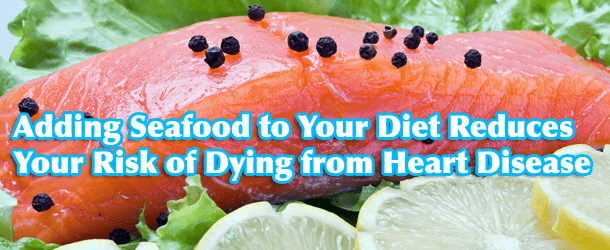
If you’re like most Americans, you’re not getting the recommended eight ounces of seafood per week; fewer than 22 percent meet this goal. And you may be missing out on an important strategy to improve your health through diet.

Seafood is a low-saturated-fat protein choice, rich in beneficial nutrients, including vitamin D, selenium and omega-3 fatty acids. Aim for at least two servings of protein-rich, low-saturated-fat seafood every week to boost heart and brain health and enhance mood.
Fishing for Healthy Nutrients
Strong evidence indicates eicosapentanenoic acid (EPA) and docosahexaenoic acid (DHA,) the essential omega-3 fats in fish, can boost heart health, as well as offer protection against depression, dementia and inflammatory disorders, such as asthma and rheumatoid arthritis.
The Dietary Reference Intake (DRI, a daily guide for intake) for omega-3 fats has not been established to date; however, the American Heart Association recommends a total of one gram of EPA plus DHA per day, preferably from oily fish, for those with heart disease. The adult DRI for vitamin D is 600 International Units, and for selenium, 55 micrograms.
Inadequate vitamin D intake is a widespread problem that may increase the risk of several diseases, including osteoporosis, infectious disease, heart disease, cancer, and seasonal flu. Poor selenium intake is linked with autism, Alzheimer’s disease, rheumatoid arthritis, and asthma.
A Sea of Benefits
Here’s a look at the latest evidence on seafood and health:
1. Heart health. Both the U.S. Department of Agriculture’s Dietary Guidelines for Americans 2010 and the American Heart Association recommend that you eat at least two servings of fish each week. Research shows that regular consumption of fish reduces the risk of dying from heart disease by 36 percent.
2. Pregnancy. The intake of omega-3s during pregnancy plays an important role in infant brain development and health. This is why the Dietary Guidelines call for women who are pregnant or breastfeeding to eat eight to 12 ounces of seafood per week. According to U.S. seafood consumption statistics, most pregnant women do not consume the recommended intake of seafood, thus they are not likely to obtain enough omega-3s in their diet.
Concerns about mercury contamination have led to both fear and confusion regarding the safety of eating fish during pregnancy. However, it’s been established that benefits outweigh potential risks.
3. Mood and brain health. It’s no surprise that seafood, a rich source of omega-3, has earned a reputation as “brain food.” Research continues to illustrate possible benefits of omega-3s in the treatment of mental disorders, including depression, Alzheimer’s disease, and neuropsychiatric disorders.
DHA is a major structural fat in the human brain, representing about 97 percent of all the brain’s omega-3 fats, and plays an important role in memory, brain performance, and behavioral function.
Benefits Outweigh Potential Risks
With so many benefits linked with eating seafood, why are people missing out on this opportunity for better health? Sylvia Geiger, M.S., R.D., registered dietitian specializing in seafood and health, spoke at the Supermarket RD Symposium in Savannah, Ga., in March.
“The nutritional benefits are overshadowed by fear of environmental contaminants, including methylmercury, dioxins and polychlorinated biphenyls (PCBs) potentially found in seafood sources, and confusion about sustainability,” Geiger reported.
But a 2006 study published in the Journal of the American Medical Association by Harvard researchers provided a poignant example quantifying the potential health benefits vs. risks for consuming seafood: The study projected that if 100,000 people ate farmed or wild salmon twice a week for 70 years, nearly 7,100 lives might be saved as a result of cardiovascular disease protection.
At the same time, only 24 deaths might result due to exposure to potential contaminants. The researchers concluded that it is far riskier to forgo the healthful nutrients derived from eating seafood than it is to avoid seafood due to fear of contaminants.
If your body has sufficient selenium to maintain proper function, the risks for mercury are mitigated, according to the Energy and Environmental Research Center, Grand Forks, N.D. Seafood is among 17 of the top 25 sources of dietary selenium consumed in the U.S.; thus, people who maintain optimal intake levels of selenium may reduce their risk of mercury exposure.
– Barbara Ruhs, M.S., R.D., L.D.N.,
Reprinted with permission from Environmental Nutrition, a monthly publication of Belvoir Media Group, LLC. 800-829-5384. www.EnvironmentalNutrition.com.
(c) 2012 BELVOIR MEDIA GROUP DISTRIBUTED BY TRIBUNE MEDIA SERVICES, INC.

